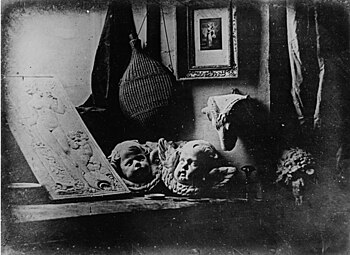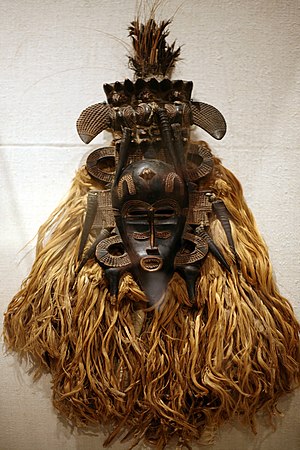Texture is the tactile sense we get from the surface of a shape or volume. Smooth, rough, velvety and prickly are examples of texture. Texture comes in two forms:
- actual, the real surface qualities we perceive by running a hand over on object, and
- visual, an implied sense of texture created by the artist through the manipulation of their materials.
An artwork can include many different visual textures but still feel smooth to the touch. Robert Rauschenberg’s Rauschenberg is well known for his “Combines” of the 1950s, in which non-traditional materials and objects were employed in innovative combinations. His mixed media print, Skyway, includes rough and smooth visual textures that add layers of perception and animate the work, drawing attention to specific areas within it. A self-portrait by Vincent van Gogh swirls with actual textures created with brushstrokes loaded with paint. The artist fixes his gaze sternly at the viewer, his spiky red beard and flowing hair rendered so texturally you want to reach out and touch them.

Louis Jacques Mande Daguerre, Still Life in the Artist’s Studio, 1837
Photographs can hold lots of visual texture. A grainy exposure adds to this effect. Louis Daguerre’s early photograph of his studio shows many objects with texture jumbled across the smooth photographic paper. These, along with the strong contrast in dark and light tones, enrich the photograph with a sense of drama not inherent to the objects themselves.
Texture in Three-dimensional Art

Senufo peoples, Face Mask (Kpeliye’e), wood, horns, raffia fiber, cotton cloth, feather, metal, sacrificial material, <a href=”
http://www.metmuseum.org/Collections/search-the-collections/50003530“>The Metropolitan Museum of Art</a>, New York City
Three-dimensional artworks make generous use of actual textures. The face mask from the Ivory Coast of Africa incorporates textures from materials ranging from wood, horns, fibers, cloth, metal and feathers. The complexity of the composition is directly related to the many textures found in the mask. For instance, the relative smoothness of the dark ovoid shape of the face focuses our attention even though it competes with the surrounding ornaments, textures and forms. The masks honor deceased elders of the Senufo tribe from the Ivory Coast.
We have now covered the essential artistic elements. Each one has its own characteristics and limitations. Used together they add variety and complexity, becoming the building blocks in creating works of art. We’ll rely on them to describe different kinds of artworks in the learning activities for this module. This will give you the practice and experience you’ll need to use description as an objective way to discuss the art you experience.
The Formalist Method describes what a person sees in a piece of art in a totally objective way and helps one to look at art in a new way. It does not require reference to any subject matter when discussing a work of art. Instead, one is required to be objective in descriptions and there is no subjective reaction to the artwork involved. It’s important to understand the Formalist Method of looking at artwork because it allows one to understand Style, the aesthetic values or physical techniques used in making art, and Form, the way a work of art looks. The Formalist Method is used to look at a piece of art that one may know nothing about to form an appreciation of it before one understands the symbols and meaning behind the work.
What was is your opinion of Rauschenberg’s “combines”? Would you call them works of art?
You must be logged in to post to WEnotes.
Note: Your comment will be displayed in the course feed.
Introduction
Texture is the tactile sense we get from the surface of a shape or volume. Smooth, rough, velvety and prickly are examples of texture. Texture comes in two forms:
An artwork can include many different visual textures but still feel smooth to the touch. Robert Rauschenberg’s Rauschenberg is well known for his “Combines” of the 1950s, in which non-traditional materials and objects were employed in innovative combinations. His mixed media print, Skyway, includes rough and smooth visual textures that add layers of perception and animate the work, drawing attention to specific areas within it. A self-portrait by Vincent van Gogh swirls with actual textures created with brushstrokes loaded with paint. The artist fixes his gaze sternly at the viewer, his spiky red beard and flowing hair rendered so texturally you want to reach out and touch them.
Texture in Photography
Photographs can hold lots of visual texture. A grainy exposure adds to this effect. Louis Daguerre’s early photograph of his studio shows many objects with texture jumbled across the smooth photographic paper. These, along with the strong contrast in dark and light tones, enrich the photograph with a sense of drama not inherent to the objects themselves.
Texture in Three-dimensional Art
Three-dimensional artworks make generous use of actual textures. The face mask from the Ivory Coast of Africa incorporates textures from materials ranging from wood, horns, fibers, cloth, metal and feathers. The complexity of the composition is directly related to the many textures found in the mask. For instance, the relative smoothness of the dark ovoid shape of the face focuses our attention even though it competes with the surrounding ornaments, textures and forms. The masks honor deceased elders of the Senufo tribe from the Ivory Coast.
Summary
We have now covered the essential artistic elements. Each one has its own characteristics and limitations. Used together they add variety and complexity, becoming the building blocks in creating works of art. We’ll rely on them to describe different kinds of artworks in the learning activities for this module. This will give you the practice and experience you’ll need to use description as an objective way to discuss the art you experience.
The Formalist Method describes what a person sees in a piece of art in a totally objective way and helps one to look at art in a new way. It does not require reference to any subject matter when discussing a work of art. Instead, one is required to be objective in descriptions and there is no subjective reaction to the artwork involved. It’s important to understand the Formalist Method of looking at artwork because it allows one to understand Style, the aesthetic values or physical techniques used in making art, and Form, the way a work of art looks. The Formalist Method is used to look at a piece of art that one may know nothing about to form an appreciation of it before one understands the symbols and meaning behind the work.
What was is your opinion of Rauschenberg’s “combines”? Would you call them works of art?
You must be logged in to post to WEnotes.
Note: Your comment will be displayed in the course feed.
Content is available under the
Creative Commons Attribution Share Alike License.
Privacy Policy | Authors